Introduction to Properties/it: Difference between revisions
| Line 27: | Line 27: | ||
Questa guida terrà in considerazione solamente la prima scheda, '''Token Properties'''. | Questa guida terrà in considerazione solamente la prima scheda, '''Token Properties'''. | ||
== | ==La scheda Properties== | ||
[[Image:Camp-props.png|thumb| | [[Image:Camp-props.png|thumb|La scheda'''Token Properties''' nelle Campaign Properties]] | ||
La prima scheda visualizzata all'apertura di Campaign Properties è la "Token Properties". Questa appare relativamente semplice, ma qui si annidano enormi potenziali. Ci sono 3 campi di testo in questa scheda: | |||
* Name: | * Name: questo è come chiamerete una selezione di proprietà esposta in basso. Quando aprite la finestra campaign properties nessuna selezione di proprietà sarà evidenziata, perciò il campo sottostante risulterà vuoto. | ||
* Type: | * Token Type: la colonna sul fianco sinistro non è editabile, elenca per nome tutte le selezioni di proprietà appartenenti alla campaign corrente. L'unica selezione predefinita esistente è '''Basic''', è presente anche se non si carica nessuna campaign. | ||
* | * Una larga area di testo dove potete immettere le proprietà per la campaign corrente. In primo luogo apparirà vuota, lo sarà fintanto che non evidenzierete il nome di una selezione di proprietà dalla lista di sinistra '''Token Type''', in questo caso compariranno le nomenclature di quella selezione con i loro valori. | ||
===Type=== | ===Token Type=== | ||
In | In questo campo potete vedere i nomi dei "Property Types" differenti (potremmo immaginarli come insiemi di proprietà) che sono stati configurati nella campaign corrente. Se nessuna campaign è caricata, l'unica selezione di proprietà presente sarà la ''Basic'', quella predefinita. Il campo '''Token Type''' non sarà direttamente editabile dall'utente. | ||
===Name=== | ===Name=== | ||
Questo è un semplice campo di testo dove potete inserire il nome che volete dare alla rispettiva selezione di proprietà. Questo nome comparirà nella lista "Token Type" di sinistra una volta fatto l'''update'' (aggiornamento) della selezione. I nomi possono essere come preferite; per esempio molti utenti creano selezioni chiamate "PNG" per distinguerli dai "PG" in quei giochi dove le statistiche e i tratti fra queste due entità differiscono. | |||
===Properties=== | ===Properties=== | ||
Qui è dove vi dovrete sbizzarrire. In questa area di testo potrete creare qualsivoglia proprietà che rifletta tutti i possibili valori numerici o statistiche attribuibili ad un personaggio da GDR (e anche altre proprietà, molti utenti ne creano alcune utili per scrivere macros ma che poi non appaiono in nessuna scheda del personaggio!). | |||
==Creating Properties== | ==Creating Properties== | ||
Revision as of 23:10, 19 October 2010
{{#customtitle:Introduzione alle Proprietà |Introduzione alle Proprietà}}
Campaign Properties
Una delle caratteristiche più utili in MapTool è la capacità dei tokens di portarsi dietro un assortimento di Properties (proprietà) allegate ad esse, che possono essere manipolate dalle macro ed usate per creare rapide esposizioni di informazioni. Di base le proprietà dei token sono come schede del personaggio incorporate.
Tuttavia, per il fatto che queste opzioni sono così utili, gli sviluppatori di MapTool hanno creato molti differenti modi di usarle e manipolarle. La presente guida tratterà della creazione di una serie di Campaign Property (proprietà campagna), della loro regolazione in valori predefiniti e di come impiegarle per plasmare gli Statsheet (schermate di statistiche).
Il Regolamento d'Esempio o MTRPG
Al fine di avere utili riferimenti durante lo svolgimento della guida, diversi collaboratori ed utenti di MapTool hanno creato il Regolamento d'Esempio -- un semplice sistema di gioco di ruolo prodotto specificatamente per illustrare parti di Maptool. Chiameremo le suddette regole "MapTool RPG" - o in breve MTRPG. Quello che andremo a fare sarà creare un nuovo Campaign File (file di campagna) e impostare diverse campaign properties che corrispondano agli attributi delle MTRPG.
La Finestra Campaign Properties
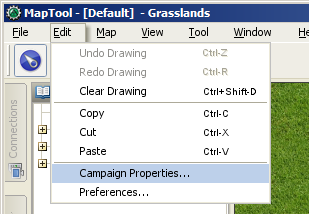
Per cominciare ad operare sulle Campaign Properties (Proprietà Campagna), la prima cosa da fare è andare su Edit > Campaign Properties così da aprire l'apposita finestra. Una volta dentro vedrete diverse schede e una mole considerevole d'informazioni.
Le schede presenti nella finestra Campaign Properties conteranno sei elementi:
- Token Properties: qui dimorano tutte le serie di proprietà che un token potrebbe adoperare nella campaign corrente
- Repositories: qui è dove potete designare un "repository" (deposito) online per contenere i campaign files, specialmente le immagini, per migliorare i tempi di caricamento e la velocità quando ospitate o partecipate ad un gioco online
- Sight: qui è dove si configurano i settaggi per le visuali della campaign corrente
- Light: qui si configurano le sorgenti di luce e le aure della campaign corrente
- States: questa scheda permette la configurazione degli stati dei token per la campaign corrente
- Bars: qui è dove si configurano le barre dei token per la campaign in corso
Questa guida terrà in considerazione solamente la prima scheda, Token Properties.
La scheda Properties
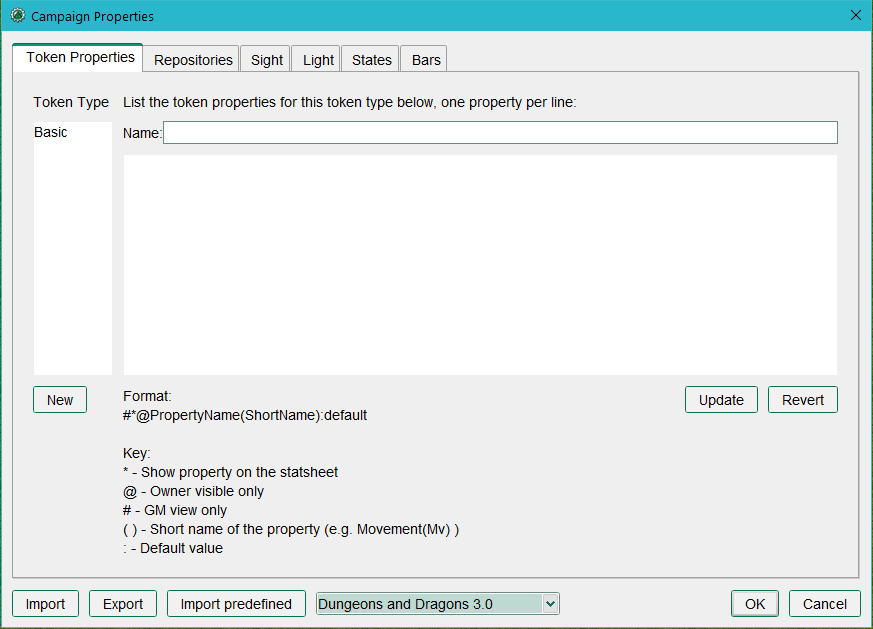
La prima scheda visualizzata all'apertura di Campaign Properties è la "Token Properties". Questa appare relativamente semplice, ma qui si annidano enormi potenziali. Ci sono 3 campi di testo in questa scheda:
- Name: questo è come chiamerete una selezione di proprietà esposta in basso. Quando aprite la finestra campaign properties nessuna selezione di proprietà sarà evidenziata, perciò il campo sottostante risulterà vuoto.
- Token Type: la colonna sul fianco sinistro non è editabile, elenca per nome tutte le selezioni di proprietà appartenenti alla campaign corrente. L'unica selezione predefinita esistente è Basic, è presente anche se non si carica nessuna campaign.
- Una larga area di testo dove potete immettere le proprietà per la campaign corrente. In primo luogo apparirà vuota, lo sarà fintanto che non evidenzierete il nome di una selezione di proprietà dalla lista di sinistra Token Type, in questo caso compariranno le nomenclature di quella selezione con i loro valori.
Token Type
In questo campo potete vedere i nomi dei "Property Types" differenti (potremmo immaginarli come insiemi di proprietà) che sono stati configurati nella campaign corrente. Se nessuna campaign è caricata, l'unica selezione di proprietà presente sarà la Basic, quella predefinita. Il campo Token Type non sarà direttamente editabile dall'utente.
Name
Questo è un semplice campo di testo dove potete inserire il nome che volete dare alla rispettiva selezione di proprietà. Questo nome comparirà nella lista "Token Type" di sinistra una volta fatto l'update (aggiornamento) della selezione. I nomi possono essere come preferite; per esempio molti utenti creano selezioni chiamate "PNG" per distinguerli dai "PG" in quei giochi dove le statistiche e i tratti fra queste due entità differiscono.
Properties
Qui è dove vi dovrete sbizzarrire. In questa area di testo potrete creare qualsivoglia proprietà che rifletta tutti i possibili valori numerici o statistiche attribuibili ad un personaggio da GDR (e anche altre proprietà, molti utenti ne creano alcune utili per scrivere macros ma che poi non appaiono in nessuna scheda del personaggio!).
Creating Properties
Properties with No Default Value
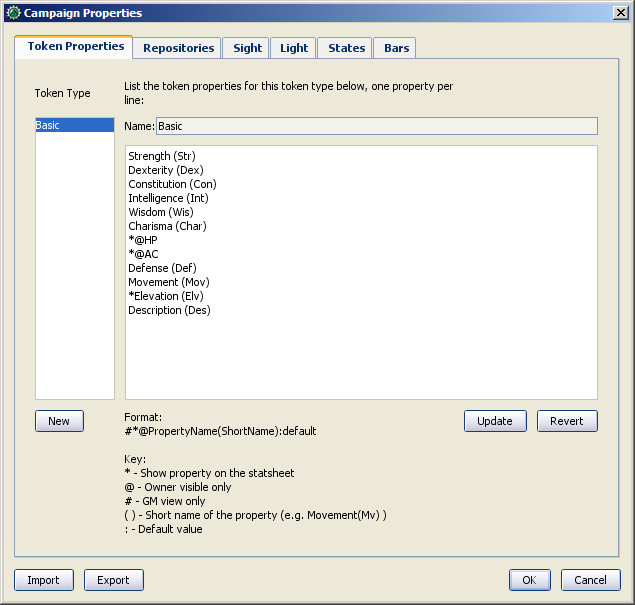
If you look at MTRPG's Primary Attributes, you will see that there are four separate attributes that are the basic attributes of a character: Strength, Dexterity, Intelligence, and Endurance. We're going to get rid of the default properties, and put new ones in their place.
1. Go to Edit > Campaign Properties. You'll see in the left side, under Token Type, that the only entry is "Basic." We're going to create a new property set.
2. In the Token Type list on the left, select Basic. When you do this, you'll see a whole bunch of properties with all kinds of symbols like @, #, and so forth.
3. In the text area with all the properties, use your mouse to highlight them all, and hit Delete on your keyboard. Go ahead - don't be shy!
4. Leave the Name field alone - MapTools must always have a Basic property set, so you can't change that name.

5. In the text area below the Name field, enter the name of each of the four Primary Attributes in MTRPG, like so:
Strength
Dexterity
Intelligence
Endurance
When done, your properties window should look like the screenshot on the right.
6. Once you've finished entering the properties you want, click the button labeled Update. Don't panic! The properties will disappear, but if you select the Basic list from the left, your properties will reappear in the main text area.
7. Click OK to confirm all of your changes and close the Campaign Properties window.
8. Go to File > Save Campaign As and save your campaign as MTRPG.cmpgn. You've now created a new campaign file, with a new set of campaign properties.
When you create properties like this -- just listing the values one after the other -- and then open a token, you will see that these properties have no value. That does not mean that they are equal to zero, or equal to a blank line - they literally have no value. This doesn't mean much for most purposes, but it is an important distinction in macro writing terms (in programming, there's a big difference between a blank string, and an actually empty variable!).
Once properties are updated, all of the tokens on the map will be updated with the new properties, and any new tokens you drop on the map will "inherit" the properties you set up.
NOTE: Property names cannot have spaces in them - so if you have a property called "Hit Points", you would need to enter it as HitPoints.
Creating Properties with Default Values

Now, in MTRPG, the minimum value an attribute can have is 1. So, it makes sense to set the default value of these properties to 1 (that way, every new token will at least have the minimum value an attribute can have). To do this:
1. Open the Campaign Properties window.
2. Select the Basic property set.
3. In the Basic Properties set, edit your properties so they now read (see the image, as well):
Strength:1
Dexterity:1
Intelligence:1
Endurance:1
4. Click Update.
By placing a colon at the end of the name of each attribute, and putting the number 1 after the colon, you have instructed MapTool that the default value for those properties is 1 (in other words, whatever value you put after the colon becomes the default value for that property). You'll note that at the bottom of the Token Properties tab there is a key describing the various options you can set on a property.
Now, if you drag a new token onto the map and look at its properties (double-click on the token and go to the Properties Tab in the Edit Token dialog), you will see that the new token has the default values.
By the way: don't worry about any tokens you may have already set the property values on - setting up or changing the default values will not override the properties you've already set. MapTool is smart enough to handle that.
Displaying Properties in the Statsheet
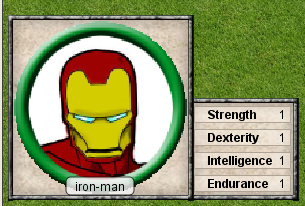
MapTool has a neat feature called the Statsheet, which is briefly mentioned in the Introduction to Tokens - basically, it is an automatic popup that appears in the lower left corner of the map, when you hover over a token.
You may be saying, "Wait...when I hover over my token, there's no statsheet! Where is it?" The reason you don't see it yet is that the Statsheet is governed by the Campaign Properties - it displays the token's properties (along with a larger version of the token's image) - but only when a couple requirements are met:
- The properties are set up to display on the statsheet; and
- The properties that are displayed actually have a value
Setting Properties to Display
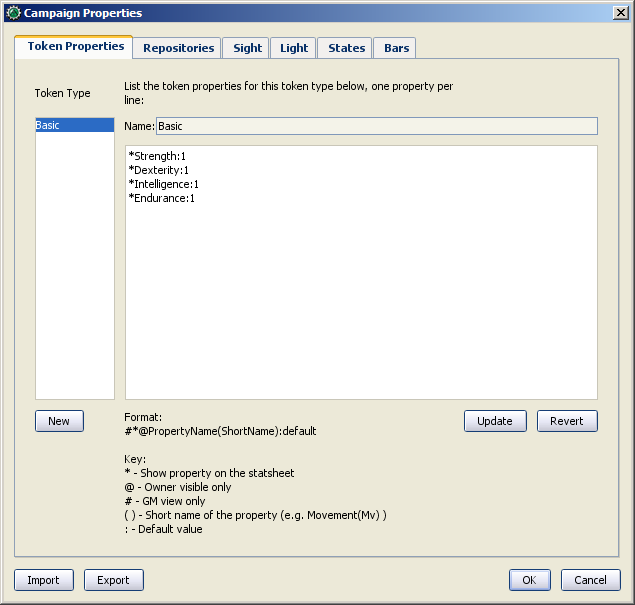
If you look at the bottom of the Token Properties tab in the Campaign Properties dialog, you'll see a key showing how to set up a property to display in the Statsheet. There are three display options, each of which is indicated by putting a symbol in front of the property name:
- *: an asterisk means "show this property on the statsheet"
- @: means "only show this property to the owner of the token (and the GM)"
- #: means "only show this property to the GM (not even the token owner can see it)"
The asterisk is required for any stat to display at all - if you don't have an asterisk first, it won't show no matter what else you put on there. The @ and # symbols, on the other hand, are optional.
So, for our new game, we're going to set all of the properties to be visible to everyone (by just using a star). To do this, open up your properties, and edit them to look like this:
*Strength:1
*Dexterity:1
*Intelligence:1
*Endurance:1
Now, when you hover over a token, you'll see the Statsheet pop up (see the screenshot, above) with the values in the Strength, Dexterity, Intelligence, and Endurance properties. Also, since even brand new tokens have a default value, the Statsheet will appear for all tokens.
Short Names
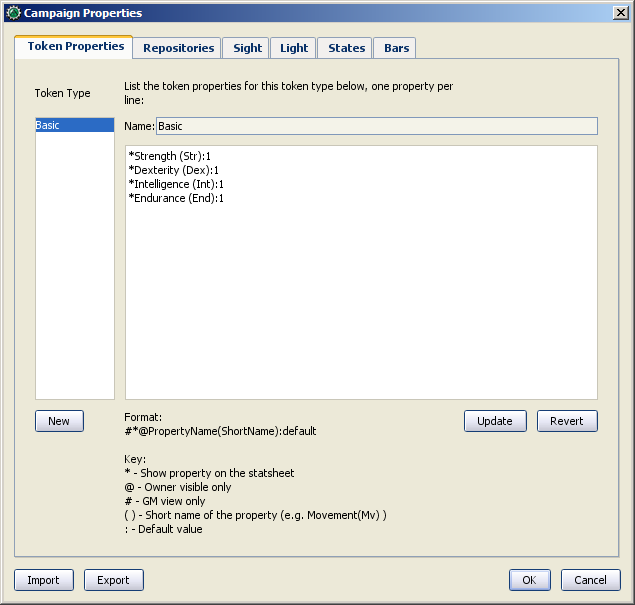
Sometimes, property names can get pretty long (or look unfriendly - no spaces, and all that). MapTool lets you put a Short Name in for each property. To do that, you just enter the short name in parentheses after the property name, like so:
*Strength(Str):1
*Dexterity(Dex):1
*Intelligence(Int):1
*Endurance(End):1
These short names are displayed in the Statsheet instead of the full name of the property
Short Names are for display purposes only - when referencing properties in macros, you must use the full property name.
Creating Derived Properties

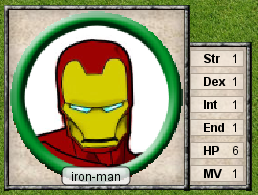
Okay, now let's do something pretty cool. In a lot of roleplaying games, there are character attributes that are derived from other stats - for instance, in the Savage Worlds rules, your "Parry" stat is based on your Fighting ability; likewise, in Dungeons & Dragons, your "Hit Points" are derived partly from your "Constitution" score.
Now, you could create these other derived attributes as separate properties and manually enter the values in when you make a new token - but how about we allow MapTool to calculate these derived values? That's right - MapTool's campaign properties can not only be numbers and text, but also calculations and equations based on other properties that the token has.
In MTRPG, there are three derived stats: Hit Points, Armor, and Movement. These stats have the short names "HP", "AR," and "MV." For this example, we're going to set up Hit Points and Movement to be calculated from existing properties. We'll leave Armor until later (it takes a bit more complex a calculation to figure out the armor value, and we're taking it slow).
First, we need to add properties for these three derived values:
1. Open up the Basic property set.
2. Beneath Endurance, enter the following:
*HitPoints(HP)
*Armor(AR)
*Movement(MV)
You'll notice at this point, we've set no default values. Don't hit Update just yet - let's enter some macro code to create a derived value.
We can see from the MTRPG rules that Hit Points is equal to the value of Endurance multiplied by 6. Replicating this calculation in the campaign properties is very simple. Edit the Hit Points property to read:
*HitPoints(HP):{Endurance * 6}
What we've done here is enter a default value for the property (remember, default values are whatever comes after the colon), and used some macro code to instruct MapTool to perform a calculation in order to find the value for the properties. Two thing are happening here:
- We've enclosed the calculations in { }, which warns MapTool that the text enclosed inside the brackets is to be handled like a macro, and not just plain text
- Inside the brackets, we've said, "Find the value of the Endurance property, multiply it by 6, and make that result the value of the Hit Points property"
Now, to handle the Movement attribute, our job is even simpler: we need to instruct MapTool to get the value of the Dexterity property, and assign that same value to the Movement property. To do so, edit the Movement property to read:
*Movement(MV):{Dexterity}
When you are finished, your full property set should look like:
*Strength:1
*Dexterity:1
*Intelligence:1
*Endurance:1
*HitPoints(HP):{Endurance * 6}
*Armor(AR)
*Movement(MV):{Dexterity}
And when you hover your mouse over a token, the Statsheet should look like the screenshot to the right. Remember, even though we've said that Armor should be displayed on the statsheet, the statsheet only shows properties that have a value - Armor is still empty, so it won't show up until you give it a value.
Saving Your Campaign
At this point, you've created a bunch of campaign properties, placed a token on the map, and messed around with manipulation of the properties you made. You should probably save your work in a [Campaign] file. This will save the tokens, properties you created, and all the information you put into the campaign so far.
Also, this will let you work on the campaign further, trying tricks from the other MapTool tutorials.
To save your campaign:
- Go to File -> Save Campaign As...
- In the dialog, enter a file name. Something like MTRPG.cmpgn is good!
- Click OK
Your campaign will now be saved, and you can open it up whenever you feel like it, and work on it some more!
Please note that campaigns saved in one version of MapTool will not open properly in an older version of MapTool; however most campaign files created in an older version can be opened in the newest version (this isn't guaranteed, though...MapTool is evolving at all times!)
Some Technical Details
A couple times in this guide and in other guides the token properties have been described as "those properties that are visible" in this campaign, or the properties set up "for this campaign." There's a reason for phrasing it like this.
See, a token - if you cut one open and looked at its inner workings - is an XML file that contains a ton of information. It has information about its image, its size, its vision, light, and shape, and - of course - its properties. What's important to understand here is that the token will remember not only the properties from the MTRPG, but if it was ever saved as an .rptok file or brought in from another campaign file, it will remember the properties from that campaign too. They won't be visible, but they're stored in the token even so.
So, in reality, a set of Campaign Properties really indicates those properties that:
- You can see if you open up a token by double-clicking on it, and
- You can directly edit by clicking in the cell next to them
This may sound like a recipe for disaster - what if you set up a property that was already set up but is hidden? Fortunately, MapTool will not, when running a macro, attempt to access any hidden properties unless you specifically instruct it to do so, using two special macro functions. So rest assured, you cannot accidentally access a property that's not set up in the Campaign Properties.
In summary, if a Property Type (such as the default Basic property type) has a property named HP, it will be stored in the token under the XML name HP. If another property type (such as a user-defined Pathfinder property type) also has a property named HP, they will both be referencing the same data on the token. Modifying the value of HP when the token is Basic and then changing the token Pathfinder will show the same value for HP.
Moving On from Here
MapTool supports very elaborate properties and derived properties, with a number of math functions and operations. A couple of the most common ones you might want to use are (the examples are not necessarily part of MTRPG; they're just examples):
- Basic math operators: addition (+), subtraction (-), multiplication (*), and division (/)
- Example: HitPoints: {Endurance * 6}
- Rounding: there are some functions to let you round numbers when you divide
- Floor: the floor() function rounds down. Example: HitPoints:{floor(Constitution / 2)} would divide Constitution by two, and round down
- Ceiling: the ceil() function works like floor(), but rounds up. Example: HitPoints:{ceil(Constitution/2)}